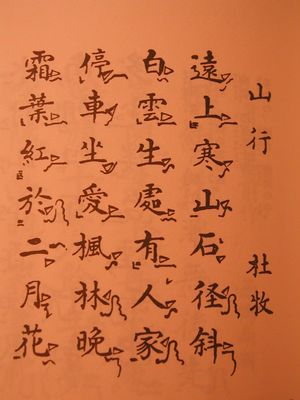Shigin: Difference between revisions
imported>Graham Nelson (cat.) |
imported>Derek Harkness (Remove wikipedia category and interwiki link) |
||
| Line 70: | Line 70: | ||
*[http://cls.admin.yzu.edu.tw/shenhg/wa15.htm Chinese recital] (in Chinese) - comparison: Chinese performance of ''Night mooring at the maple bridge'' (NB. ''not'' in Shigin form) | *[http://cls.admin.yzu.edu.tw/shenhg/wa15.htm Chinese recital] (in Chinese) - comparison: Chinese performance of ''Night mooring at the maple bridge'' (NB. ''not'' in Shigin form) | ||
[[Category: Literature Workgroup]] | [[Category: Literature Workgroup]] | ||
Revision as of 21:49, 28 July 2007
Shigin (詩吟) is a form of Japanese poetry, which is usually chanted, either individually or within a group.
Individual poems are termed gin (吟), and are usually composed of four or more lines of Chinese characters, or kanji (漢字), each line having the same number of characters. Gin with four phrases each seven characters long (the most common) are classified as shichigon-zekku (七言絶句), literally seven-word quatrains.
There is strictly only one standard melody, although many poems will be distinguished by minor variations from this theme.
The example below illustrates a typical gin from China:
|
楓橋夜泊 月落烏啼霜満天 江楓漁火對愁眠 姑蘇城外寒山寺 夜半鐘声到客船 |
Night mooring at the maple bridge The moon falls, crows call, frosty mists fill the heavens Looking out from maple bridge, distant fishing lamps pierce these lonely eyes Outside Suzhou City, from the Cold Mountain Temple The midnight gong rings out, as the boats return |
(NB: Subject terms have been added to give a sense to the poem, but no such terms exist in the original Japanese.)
Performance
Members of a Shigin group will usually gather to train in a washitsu, or Japanese-style room with tatami matting. Practicers kneel in the seiza position, thought to be the optimum posture to allow strong and steady projection during chanting.
Pariticipants are encouraged to focus their energy in their gut (thought in Zen to be the locus of power) and sing by slowly expelling this energy. Conversely, singing from the chest, as would be encouraged in classical Western operatic style, is deemed unauthentic.
During practice, members may refer to the written gin to aid memory. This is usually annotated, with marks to the right of each character denoting how the tone should vary through the length of its vocalisation.
Breathing intervals are indicated by right-angular strokes to the left of the character (a typical gin will last approximately one and a half minutes, in four breaths). Finally, because Japanese and Chinese word orders differ, further (sino) numerical marks to the left of some characters indicate their correct sequence.
Gin are formally performed standing, and from memory. Because of this, recital of longer gin is sometimes seen as more accomplished (being harder to remember, and more likely to vary from the standard melodic form). The vocal may be accompanied by traditional Japanese instruments such as the Koto or Shakuhachi. Dress may be Western (suit) or traditional (kimono or yukata).
History
Shigin are thought to have originated in China early in the first millennium AD, and may have entered Japan amongst other texts brought back from China in the 5th century. They were most likely sung originally in Chinese, but were later given Japanese readings, which are used in their contemporary recital. New gin were written, often detailing particular Japanese concepts or events, but the standard written layout has remained.
Shigin are thus significantly older than other, more popular Japanese poetry forms, such as Haiku. Their practice is now a minority art, mostly confined to the elderly and little known amongst younger generations. Nevertheless, several Shigin festivals are held throughout the year, including the Autumn Shigin Festival (秋吟会) in Shiogama, in the North-East (Tōhoku) region of Japan. Gin are also sung at Buddhist ceremonies and quasi-religious gatherings in Japan.
Moreover, although largely in anonymity, Shigin continue to have a significant influence on Japanese culture. Individual poems are often studied in Japanese textbooks, and are regularly displayed at exhibitions of Japanese calligraphy.
Notes
- [1] Yomiuri Shinbun article
- www.shigin.com (in Japanese)
- 判り易い詩の吟じ方 (Wakari-yasui Shi no Ginjikata) - Japanese Shigin manual
External links
- 2005 Hisho Shigin festival: audio (Japanese) - click on entries to hear recital (RealAudio required)
- Chinese recital (in Chinese) - comparison: Chinese performance of Night mooring at the maple bridge (NB. not in Shigin form)



